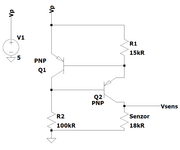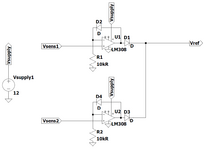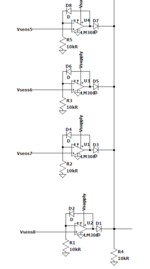shmup
Newbie
Hello,
so I am having trouble with my project that professor tasked me with(This is not homework or something like that, I do not get any grades\points for this). I'm trying to design a primitive and basic circuit for "correcting" patients walk. Basically I plan on having 8 sensors in shoe that will read force measurement and give me somewhat equivalent voltage.Then I would use that voltage to find which sensor is most pressured and I would turn on the LED that corresponds the the most pressured sensor.In the assignment it's said that my sensors are FSR with positive resistance increase of 2kΩ/kg and that I would turn on only 1 LED unless there are 2 voltages that have values close to each other(+/- 10%) .This project has to be done in Analog, and I should mostly use op-amps and comparators.
So far I've created this current source so I could have linear force-to-voltage output.

My next step was to find the max voltage out of all and compare it to the voltage of the sensors and turn on the LED that matches the voltage.

However my professor said that it's a bad idea and that op-amps would not be linear since they don't have feedback loop.He said I should be better of using comparators and instead of matching 2 or more voltages I should focus on difference between voltages.
My question is, how could find out which LED should I turn on using comparator/op-amps?
Any help would be much appreciated since this is my "intro" into Digital electronics!
so I am having trouble with my project that professor tasked me with(This is not homework or something like that, I do not get any grades\points for this). I'm trying to design a primitive and basic circuit for "correcting" patients walk. Basically I plan on having 8 sensors in shoe that will read force measurement and give me somewhat equivalent voltage.Then I would use that voltage to find which sensor is most pressured and I would turn on the LED that corresponds the the most pressured sensor.In the assignment it's said that my sensors are FSR with positive resistance increase of 2kΩ/kg and that I would turn on only 1 LED unless there are 2 voltages that have values close to each other(+/- 10%) .This project has to be done in Analog, and I should mostly use op-amps and comparators.
So far I've created this current source so I could have linear force-to-voltage output.

My next step was to find the max voltage out of all and compare it to the voltage of the sensors and turn on the LED that matches the voltage.

However my professor said that it's a bad idea and that op-amps would not be linear since they don't have feedback loop.He said I should be better of using comparators and instead of matching 2 or more voltages I should focus on difference between voltages.
My question is, how could find out which LED should I turn on using comparator/op-amps?
Any help would be much appreciated since this is my "intro" into Digital electronics!
